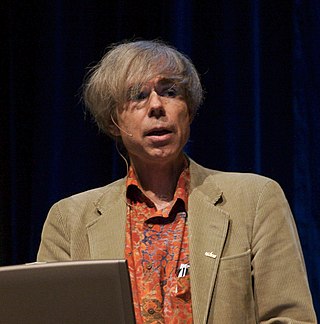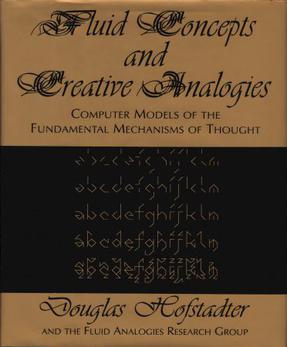
Douglas Richard Hofstadter is an American scholar of cognitive science, physics, and comparative literature whose research includes concepts such as the sense of self in relation to the external world, consciousness, analogy-making, artistic creation, literary translation, and discovery in mathematics and physics. His 1979 book Gödel, Escher, Bach: An Eternal Golden Braid won both the Pulitzer Prize for general nonfiction and a National Book Award for Science. His 2007 book I Am a Strange Loop won the Los Angeles Times Book Prize for Science and Technology.

Analogy is a comparison or correspondence between two things because of a third element that they are considered to share.

In artificial intelligence, symbolic artificial intelligence is the term for the collection of all methods in artificial intelligence research that are based on high-level symbolic (human-readable) representations of problems, logic and search. Symbolic AI used tools such as logic programming, production rules, semantic nets and frames, and it developed applications such as knowledge-based systems, symbolic mathematics, automated theorem provers, ontologies, the semantic web, and automated planning and scheduling systems. The Symbolic AI paradigm led to seminal ideas in search, symbolic programming languages, agents, multi-agent systems, the semantic web, and the strengths and limitations of formal knowledge and reasoning systems.
Semantic memory refers to general world knowledge that humans have accumulated throughout their lives. This general knowledge is intertwined in experience and dependent on culture. New concepts are learned by applying knowledge learned from things in the past.
In computer science, a metaobject is an object that manipulates, creates, describes, or implements objects. The object that the metaobject pertains to is called the base object. Some information that a metaobject might define includes the base object's type, interface, class, methods, attributes, parse tree, etc. Metaobjects are examples of the computer science concept of reflection, where a system has access to its own internal structure. Reflection enables a system to essentially rewrite itself on the fly, to alter its own implementation as it executes.
Soar is a cognitive architecture, originally created by John Laird, Allen Newell, and Paul Rosenbloom at Carnegie Mellon University. It is now maintained and developed by John Laird's research group at the University of Michigan.
ACT-R is a cognitive architecture mainly developed by John Robert Anderson and Christian Lebiere at Carnegie Mellon University. Like any cognitive architecture, ACT-R aims to define the basic and irreducible cognitive and perceptual operations that enable the human mind. In theory, each task that humans can perform should consist of a series of these discrete operations.

A Bongard problem is a kind of puzzle invented by the Russian computer scientist Mikhail Moiseevich Bongard, probably in the mid-1960s. They were published in his 1967 book on pattern recognition. The objective is to spot the differences between the two sides. Bongard, in the introduction of the book credits the ideas in it to a group including M. N. Vaintsvaig, V. V. Maksimov, and M. S. Smirnov.

Egbert B. Gebstadter is a fictional author who appears in the indexes of books by Douglas R. Hofstadter. For each Hofstadter book, there is a corresponding Gebstadter book. His name is derived from "GEB", the abbreviation for Hofstadter's first book Gödel, Escher, Bach: An Eternal Golden Braid; the letters appear in his last name, permuted in his first name, and permuted again in his initials.

In computer science, the syntax of a computer language is the rules that define the combinations of symbols that are considered to be correctly structured statements or expressions in that language. This applies both to programming languages, where the document represents source code, and to markup languages, where the document represents data.
Melanie Mitchell is an American scientist. She is the Davis Professor of Complexity at the Santa Fe Institute. Her major work has been in the areas of analogical reasoning, complex systems, genetic algorithms and cellular automata, and her publications in those fields are frequently cited.

Fluid Concepts and Creative Analogies: Computer Models of the Fundamental Mechanisms of Thought is a 1995 book by Douglas Hofstadter and other members of the Fluid Analogies Research Group exploring the mechanisms of intelligence through computer modeling. It contends that the notions of analogy and fluidity are fundamental to explain how the human mind solves problems and to create computer programs that show intelligent behavior. It analyzes several computer programs that members of the group have created over the years to solve problems that require intelligence.
Psi-theory, developed by Dietrich Dörner at the University of Bamberg, is a systemic psychological theory covering human action regulation, intention selection and emotion. It models the human mind as an information processing agent, controlled by a set of basic physiological, social and cognitive drives. Perceptual and cognitive processing are directed and modulated by these drives, which allow the autonomous establishment and pursuit of goals in an open environment.
Neural modeling field (NMF) is a mathematical framework for machine learning which combines ideas from neural networks, fuzzy logic, and model based recognition. It has also been referred to as modeling fields, modeling fields theory (MFT), Maximum likelihood artificial neural networks (MLANS). This framework has been developed by Leonid Perlovsky at the AFRL. NMF is interpreted as a mathematical description of the mind's mechanisms, including concepts, emotions, instincts, imagination, thinking, and understanding. NMF is a multi-level, hetero-hierarchical system. At each level in NMF there are concept-models encapsulating the knowledge; they generate so-called top-down signals, interacting with input, bottom-up signals. These interactions are governed by dynamic equations, which drive concept-model learning, adaptation, and formation of new concept-models for better correspondence to the input, bottom-up signals.
The LIDA cognitive architecture is an integrated artificial cognitive system that attempts to model a broad spectrum of cognition in biological systems, from low-level perception/action to high-level reasoning. Developed primarily by Stan Franklin and colleagues at the University of Memphis, the LIDA architecture is empirically grounded in cognitive science and cognitive neuroscience. In addition to providing hypotheses to guide further research, the architecture can support control structures for software agents and robots. Providing plausible explanations for many cognitive processes, the LIDA conceptual model is also intended as a tool with which to think about how minds work.
Cognitive musicology is a branch of cognitive science concerned with computationally modeling musical knowledge with the goal of understanding both music and cognition.
Robert M. French is a research director at the French National Centre for Scientific Research. He is currently at the University of Burgundy in Dijon. He holds a Ph.D. from the University of Michigan, where he worked with Douglas Hofstadter on the Tabletop computational cognitive model. He specializes in cognitive science and has made an extensive study of the process of analogy-making.
Secondary consciousness is an individual's accessibility to their history and plans. The ability allows its possessors to go beyond the limits of the remembered present of primary consciousness. Primary consciousness can be defined as simple awareness that includes perception and emotion. As such, it is ascribed to most animals. By contrast, secondary consciousness depends on and includes such features as self-reflective awareness, abstract thinking, volition and metacognition. The term was coined by Gerald Edelman.








